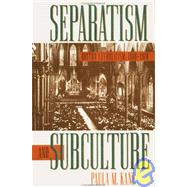Separatism and Subculture : Boston Catholicism, 1900-1920
, by Kane, Paula M.- ISBN: 9780807821282 | 0807821284
- Cover: Hardcover
- Copyright: 5/1/1994
Arguing that Catholicism was a central integrating force among different ethnic and class groups, Paula Kane explores the role of religious identity in Boston in the early twentieth century. In Separatism and Subculture she traces the effect of changing class status on religious identity and solidarity, and she delineates the social and cultural meaning of Catholicism in a city where Yankee Protestant nativism persisted even as its hegemony was in decline. While the Catholic Church served as a force for integration and acculturation in Boston, it also provided a distinct subculture for the city's Catholics in order to maintain its influence in the lives of the faithful. By the early twentieth century, Catholics had begun to achieve the economic success that was essential to cultural assimilation. But Church leaderswhile acknowledging the importance of this developmentnevertheless directed Catholics to reject secular modernity for the sanctity of the Church. To implement this strategy of separatist integration, clergy and laity coordinated existing charities, social services, and schools into a specifically Catholic refuge. New institutions emerged as well as did displays of Catholic identity such as parades, public forums, and proselytizing campaigns. Under Archbishop William O'Connell, the Church relied upon its dual insider-outsider image to unify the Catholic community and avert the contradictions of assimilation. These contradictions, says Kane, reflected Catholic ambivalence toward secular culture and concern over social and economic matters, including gender roles and feminism, capitalism, individualism, and the role of the state in philanthropy and social reform. In her analysisof Catholic lay experience, Kane makes use of a wide range of sources, from conversion narratives, fiction, and poetry to the voluminous outpourings of the Catholic press, and she juxtaposes Catholics' responses to various aspects of high culture - including aesthetics, architecture, literature, and medievalism - with their reactions to such popular diversions as dime novels, the stories of the muckraking press, vaudeville, and films.







